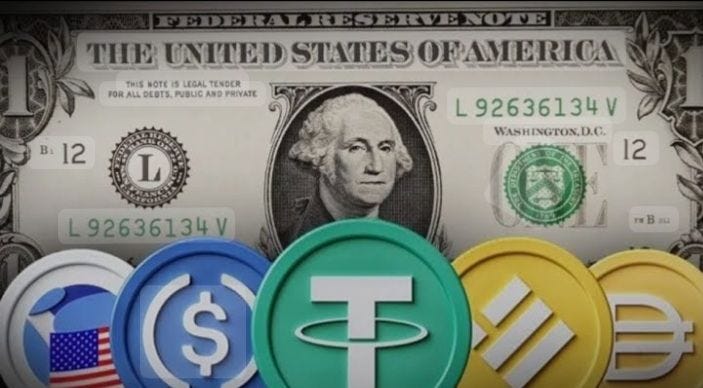a reposting from The China Academy
Jul 10, 2025
Editor’s Note: China’s Former Finance Minister says that the centralized nature of the US’s stablecoin warrants China’s utmost attention. The following article is a translated and abridged version of a forum speech originally delivered in Chinese by former Finance Minister Zhu Guangyao.
On June 17, the U.S. Senate passed the Stablecoin Bill—an adjustment of strategic importance. Following this, U.S. President Trump, Vice President Vance, and Treasury Secretary Bessent all issued policy statements.
Trump declared that the Stablecoin Bill passed by the Senate would make the United States the undisputed global leader in digital assets. He urged the House of Representatives to swiftly pass the bill. According to the schedule, the House will begin deliberations as early as the week of July 7. Trump said, “Once it passes, I’ll sign it immediately—we aim for implementation by August 1.”
Vice President Vance went even further, stating clearly that dollar-pegged stablecoins would act as a force multiplier for the U.S. economy. Through blockchain-based payment systems, the dollar would circulate more efficiently and at lower cost, thereby maintaining its global dominance.
Treasury Secretary Bessent remarked that the current administration is committed to preserving and strengthening the dollar’s status as the world’s reserve currency. Stablecoins backed by U.S. Treasury bonds or short-term T-bills would create a market that expands the global use of the dollar, while also reducing government borrowing costs and helping to manage national debt. These statements from top U.S. officials clearly outline the policy intent: to preserve the dollar’s role as an international reserve currency and uphold U.S. financial hegemony. This aligns closely with our own research on the so-called third phase of the Bretton Woods system. The U.S. is strategically tying stablecoins to its comprehensive national power and to reducing the cost of issuing its sovereign debt.
Let’s briefly examine some key features of U.S. dollar-based stablecoins:
First, every dollar stablecoin issued must be directly backed 1:1 by U.S. capital. Moreover, the underlying assets must be either U.S. cash or Treasury bonds with a maturity of 93 days or less.
Let me clarify: the 93-day requirement doesn’t mean long-term bonds are invalid, but that they must be within 93 days of maturity, ensuring full liquidity. Deposits and money market funds are also highly liquid dollar assets. In my view, this defines the third phase of the Bretton Woods system—U.S. stablecoins pegged to highly liquid dollar assets. This characteristic is particularly pronounced and tightly regulated: issuance must occur within the U.S., under U.S. institutional oversight.
Currently, Tether is the most widely circulated stablecoin, but its issuing institution is based in El Salvador. This may be tolerated during a transitional period, but after that, issuers must comply with U.S. registration and regulation requirements. This is long-arm jurisdiction under new circumstances, and for the U.S., dollar-based stablecoins are a matter of strategic interest.
We must seriously analyze the emergence of dollar stablecoins. A few years ago, Facebook attempted to launch Libra, which was to be pegged to the IMF’s currency basket. The U.S. strongly opposed it. Meanwhile, the U.S. has also studied central bank digital currencies (CBDCs). However, the Republican Party’s campaign platform explicitly opposes CBDCs. After taking office, Trump signed an executive order outright banning the development of CBDCs in the United States.
Recognizing that U.S. dollar stablecoins—tightly linked to dollar liquidity—are aimed at preserving dollar hegemony, we must also understand that their development responds to technological revolutions and innovation. These technological advancements are the core driving force and foundation for the emergence of stablecoins.
With the development of blockchain technology, real-world assets (RWAs)—that is, assets with a physical form or confirmed ownership rights outside the digital or virtual realm, such as real estate, stocks, bonds, and receivables—have become increasingly integrated. RWAs are central components of the traditional financial system, offering real economic value and broad applicability.
The core of RWA digitization lies in transforming these assets into digital tokens via blockchain technology. This process, known as asset tokenization, enables traditional assets to be transacted, circulated, and managed on-chain. It represents a fundamental transformation of the entire financial system.
In practical use, stablecoins now possess all the functions of payment, circulation, and settlement. In effect, blockchain’s decentralized nature allows transactions to be completed directly between parties without intermediaries. We must acknowledge that blockchain is inherently decentralized—but the U.S., through a series of regulatory frameworks, has made the issuance of dollar stablecoins highly centralized.
This distinction must not be misunderstood. I urge our experts in particular to stop calling this decentralized—it is in fact strong centralization, and a clear victory for that model. We must pay close attention to this evolution.
The implementation of fiat-pegged stablecoins—whether pegged to the dollar or to other currencies—along with their issuance and regulation, is not a triumph of decentralized finance (DeFi), but a manifestation of sovereign authority. This presents a challenge to all nations around the world. What should other countries do?
If the United States is allowed to dominate this area unilaterally, it will fully control the third phase of the Bretton Woods system. Therefore, China needs both a strong domestic policy response and robust international policy coordination.




